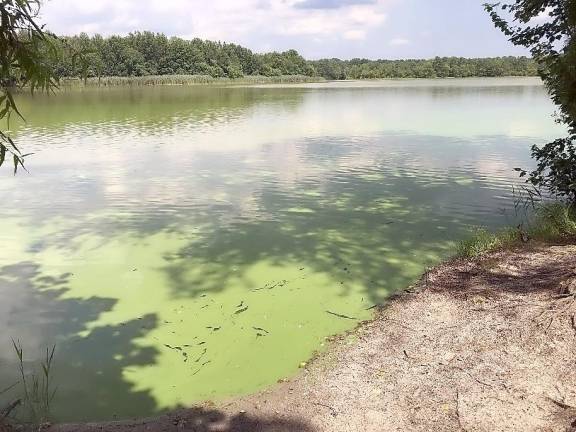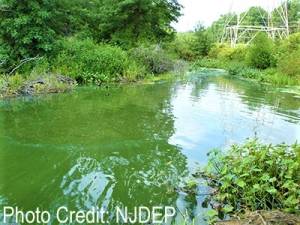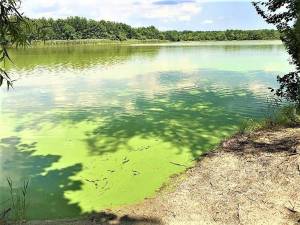NJ DEP gives Greenwood Lake Commission $53K to fight HABS
West Milford. The New Jersey Department of Environmental Protection awarded the Greenwood Lake Commission some $53,000 in a matching grant to study the amount of nutrients from Belcher’s Creek that are causing Harmful Algal Blooms to thrive, officials announced Tuesday. The money comes from $2.5 million earmarked by Gov. Phil Murphy as part of his $13 million plan to fight the blooms that devastated lake businesses throughout the state last summer.

The Greenwood Lake Commission will be getting some $53,000 in matching grant money to study how much Belcher’s Creek contributes to the Harmful Algal Blooms that devastated local lakefront businesses last summer.
The New Jersey Department of Environmental Protection announced the grants to nine different lake organizations Tuesday afternoon.
According to the agency, the money represents $2.5 million of Gov. Phil Murphy’s $13 million plan to combat the algae blooms that can be harmful to both humans and animals.
The DEP identified the naturally occurring blooms in 39 different New Jersey lakes last summer, including the state’s two largest freshwater bodies of Lake Hopatcong and Greenwood Lake.
The agency issued no contact advisories on those lakes, wreaking havoc on the tourist trade in those communities.
The blooms are fueled by phosphorus and other nutrients that runoff into the lake, experts have said.
Murphy’s program funds projects that seek to reduce the creation and impact of the blooms.
The funds are two-thirds of the respective project costs, with the remaining third paid by the organization or community getting the money, according to the state.
The amount received by each organization is based on the rating of the proposed project, according to the DEP press release.
While Greenwood Lake will get around $53,000 for its project, Lake Mohawk in Sparta will see $160,000 for a project there.
The New Jersey Institute of Technology was the largest recipient, getting some $500,000 for installation and evaluation of floating mobile platforms in Branch Brook Lake in Essex County and Deal Lake in Monmouth County with micro-nano bubble generators. These machines pump microscopic bubbles into the water column to improve dissolved oxygen. The 36-month project will also include development of a long-term harmful algal bloom strategy for Branch Brook Lake, according to the agency.
Greenwood Lake Commission Co-Chairman Paul Zarrillo said Tuesday that the money for the Belcher’s Creek project is welcome.
“We are obviously happy that the GLC's grant proposal was accepted by the NJDEP,” Zarrillo said. ”It's a very small first step of what is needed to help protect and clean up Belcher Creek, which leads into Greenwood Lake.”
Zarrillo said that the creek, located in West Milford Township on the New Jersey side, may cause up to 40 percent of the pollutants going into the water, and is a needed step in cleaning up the lake.
While pleased with the money for the project, of which, the commission will pay around $25,000 for, Zarrillo said that it was disappointing the Gov. Murphy vetoed $500,000 in annual funding for Greenwood Lake earlier this year.
That bi-partisan bill passed both houses of the state Legislature in Trenton.
“It's so unfortunate that Gov. Murphy saw fit to veto our much needed bill to receive $500,000 annually,” he said. “That veto kept the commission from receiving upwards of $500,000 from this grant, almost 10 times of what the commission will receive.”
According to the DEP, Greenwood Lake’s award is the smallest of the nine grants awarded Tuesday.
Zarrillo said that state lawmakers are currently working on three bills to help the lake and that the public should contact their state representatives to get them through the process.
“Not only does Greenwood Lake waters go to over three million residents, but thousands of businesses, which is vital to the local and state economies,” he said.
New Jersey State Assemblywoman BettyLou DeCroce, R-26, said the funding is a good “first step,” but more help is needed.
“I’m encouraged that Lake Hopatcong and Greenwood Lake were provided a share of the $2.5 million in matching funds Governor Murphy and the state Department of Environmental Protection made available to combat the harmful algal blooms before the start of a new summer season,” Assemblywoman DeCroce said. “But we know much more is needed to protect these natural public gems. We need to establish an annual funding stream to undertake the basic long-term management of these lakes, and we need an immediate investment of millions of dollars to deal with the storm water management and septic problems causing the harmful algal blooms.”
She is sponsoring legislation that would allow constitutionally dedicated corporate business tax revenues in the "Watershed Management Fund" used for grants to local governments to fund sewer and storm water infrastructure projects that reduce pollution pouring into waterways.
“It's so unfortunate that Gov. Murphy saw fit to veto our much needed bill to receive $500,000 annually. That veto kept the commission from receiving upwards of $500,000 from this grant, almost 10 times of what the commission will receive.” - Greenwood Lake Commission Co-Chairman Paul Zarrillo



